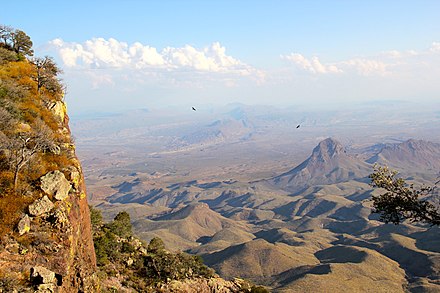The Southwestern United States, also known as the American Southwest or simply the Southwest, is a geographic and cultural region of the United States that includes Arizona and New Mexico, along with adjacent portions of California, Colorado, Nevada, Oklahoma, Texas, and Utah. The largest cities by metropolitan area are Phoenix, Las Vegas, El Paso, Albuquerque, and Tucson.[2] Before 1848, in the historical region of Santa Fe de Nuevo México as well as parts of Alta California and Coahuila y Tejas, settlement was almost non-existent outside of Nuevo México's Pueblos and Spanish or Mexican municipalities. Much of the area had been a part of New Spain and Mexico until the United States acquired the area through the Treaty of Guadalupe Hidalgo in 1848 and the smaller Gadsden Purchase in 1854.
While the region's boundaries are not officially defined, there have been attempts to do so.[3] One such definition is from the Mojave Desert in California in the west (117° west longitude) to Carlsbad, New Mexico in the east (104° west longitude); another says that it extends from the Mexico–United States border in the south to the southern areas of Colorado, Utah, and Nevada in the north (39° north latitude).[4] In another definition, the core Southwestern U.S. includes only the states of Arizona and New Mexico; others focus on the land within the old Spanish and Mexican borders of the Nuevo México Province or the later American New Mexico Territory.[5][6][7]
Distinct elements of the Western lifestyle thrive in the region, such as Western wear and Southwestern cuisines, including Native American, New Mexican, and Tex-Mex, or various genres of Western music like Indigenous, New Mexico, and Tejano music styles.[8][9][10][11] Likewise with the sought-after Southwestern architectural styles in the region inspired by blending Pueblo and Territorial styles, with Mediterranean Revival, Spanish Colonial architecture, Mission Revival architecture, Pueblo Deco, and Ranch-style houses in the form of the amalgamated Pueblo Revival and Territorial Revival architectures.[12][13][14][15] This is due to the region's caballero heritage of the Native American (especially Apache, Pueblo, and Navajo), Hispano, Mexican American, and frontier cowboy.[16][17][18][19]

The geography of the region is mainly made up of four features: the Mojave, Sonoran, and Chihuahuan Deserts, and the Colorado Plateau; although there are other geographical features as well, such as a portion of the Great Basin Desert. The deserts dominate the southern and western reaches of the area, while the plateau (which is largely made up of high desert) is the main feature north of the Mogollon Rim.[20] The two major rivers of the region are the Colorado River, running in the northern and western areas, and the Rio Grande, running in the east, north to south.

Formed approximately 8000 years ago, the Chihuahuan Desert is a relatively dry desert,[21] although it is slightly wetter than the Sonoran Desert to the west.[20] The Chihuahuan Desert spreads across the southeastern portion of the region, covering from southeastern Arizona, across southern New Mexico, and the portion of western Texas included in the Southwest.[21] While it is the second largest desert in the United States,[20] only a third of the desert is within the United States, with the rest in Mexico.[22] El Paso and Albuquerque are the major US cities in this desert, with other smaller cities being Las Cruces and Roswell in New Mexico and Willcox in Arizona.[20]
The elevation in the Chihuahuan varies from about 1,750 to 6,000 feet (500 to 1,800 meters), as there are several larger mountain ranges, such as the Organ Mountains, the Guadalupe Mountains, and the Chiracahua Mountains, plus many smaller mountain ranges contained in the area, namely the Animas, San Andres, and Doña Ana Mountains in New Mexico; and the Franklin, Hueco, and Davis Mountains in Texas. It also reaches up into the foothills of the higher ranges such as the Black Range and